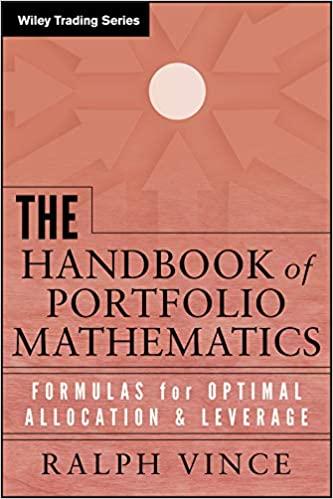Answered step by step
Verified Expert Solution
Question
1 Approved Answer
Megafund financing methods for funding early-stage translational research often require billions of dollars in capital to diversify idiosyncratic scientific and clinical risk enough to attract



Megafund financing methods for funding early-stage translational research often require billions of dollars in capital to diversify idiosyncratic scientific and clinical risk enough to attract private- sector capital. In this problem set we apply this financing method to orphan drug development, where development costs, failure rates, and correlations are low, and therefore the amount of capital required to de-risk these portfolios is much lower. Consider a portfolio of 8 preclinical orphan drug compounds each initially acquired and developed using US$25 million of capital. Assume this capital is used to first purchase and then develop the compounds, with excess capital not currently deployed earning a 0% return in cash. For simplicity, also assume that compounds are sold once they (successfully) complete the preclinical phase. We will perform a statistical analysis to estimate the expected return of this investment over the initial preclinical research phase. Assume that 40% of the total capital required to form the orphan drug portfolio is financed by selling fixed-income securities that mature at the end of the preclinical phase, and the residual capital is in the form of equity. Furthermore, assume that the yield-to-maturity on these fixed- income securities is 5% per year, and their coupon rate is 0% (i.e., they have no coupon payments). What is the expected value and standard deviation of the return on equity? Hint: There are 9 possible scenarios to consider as possible outcomes, and their probabilities can be calculated using the interactive calculator. (Note: Your answer should be a number in percentage form. Do not enter '%'.) E[R] % SD (R) = % Megafund financing methods for funding early-stage translational research often require billions of dollars in capital to diversify idiosyncratic scientific and clinical risk enough to attract private- sector capital. In this problem set we apply this financing method to orphan drug development, where development costs, failure rates, and correlations are low, and therefore the amount of capital required to de-risk these portfolios is much lower. Consider a portfolio of 8 preclinical orphan drug compounds each initially acquired and developed using US$25 million of capital. Assume this capital is used to first purchase and then develop the compounds, with excess capital not currently deployed earning a 0% return in cash. For simplicity, also assume that compounds are sold once they (successfully) complete the preclinical phase. We will perform a statistical analysis to estimate the expected return of this investment over the initial preclinical research phase. Assume that 40% of the total capital required to form the orphan drug portfolio is financed by selling fixed-income securities that mature at the end of the preclinical phase, and the residual capital is in the form of equity. Furthermore, assume that the yield-to-maturity on these fixed- income securities is 5% per year, and their coupon rate is 0% (i.e., they have no coupon payments). What is the expected value and standard deviation of the return on equity? Hint: There are 9 possible scenarios to consider as possible outcomes, and their probabilities can be calculated using the interactive calculator. (Note: Your answer should be a number in percentage form. Do not enter '%'.) E[R] % SD (R) = %
Step by Step Solution
There are 3 Steps involved in it
Step: 1

Get Instant Access to Expert-Tailored Solutions
See step-by-step solutions with expert insights and AI powered tools for academic success
Step: 2

Step: 3

Ace Your Homework with AI
Get the answers you need in no time with our AI-driven, step-by-step assistance
Get Started


